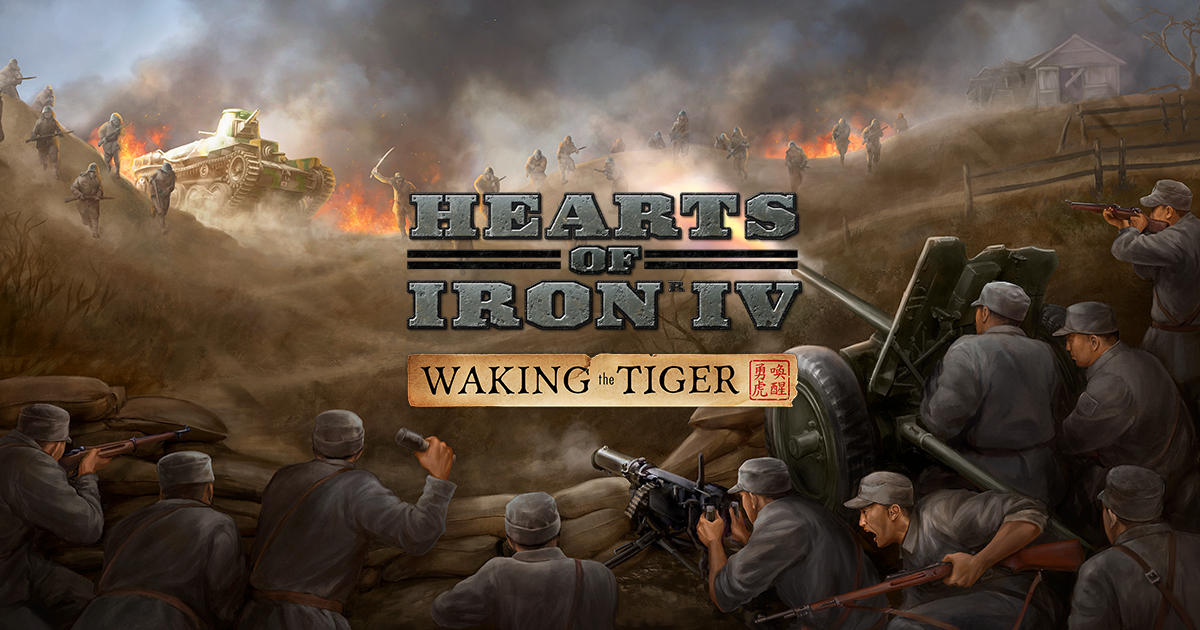Being a serious attempt at explaining the revised peace conference mechanics as introduced in the By Blood Alone (BBA) and Avalanche update.
Introduction
This illustrated guide intends to fill in some knowledge gaps that are apparent in the HOI4 community with respect to the Peace Conference changes introduced in the By Blood Alone/Avalanche update. The below guidance is based on in-game observations and some digging around in the game files. If anything appears incorrect based on your observations, please raise this for discussion in comments below.
As depicted below, the new Peace Conference interface is divided into four areas:
- Top panel – World tension, war score, and turn information.
- Left panel – Make Demands panel, which lists available demands, listed by type and defeated country, and allows the player to select or deselect demands for submission.
- Right panel – Current Demands panel, listing un-submitted and submitted demands by each victor country listed on the right. Un-submitted demands may be deselected from this panel.
- Map – As with the previous UI, a map in the center shows the effects of submitted demands and may also be used to select or deselect states for demands.
As in previous versions, countries make demands at the expense of war score, which is based on participation in the conflict. This guide will provide an overview of war score factors as of the 1.12.5 patch. For later patches, I recommend checking the latest patch notes for updates on changes to war score factors.
All victors submit demands simultaneously during each turn instead of in sequential turns as in the previous version of this mechanic. If multiple victors bid on the same state, it becomes a contested state, with impacts on demand costs that increase with each turn.
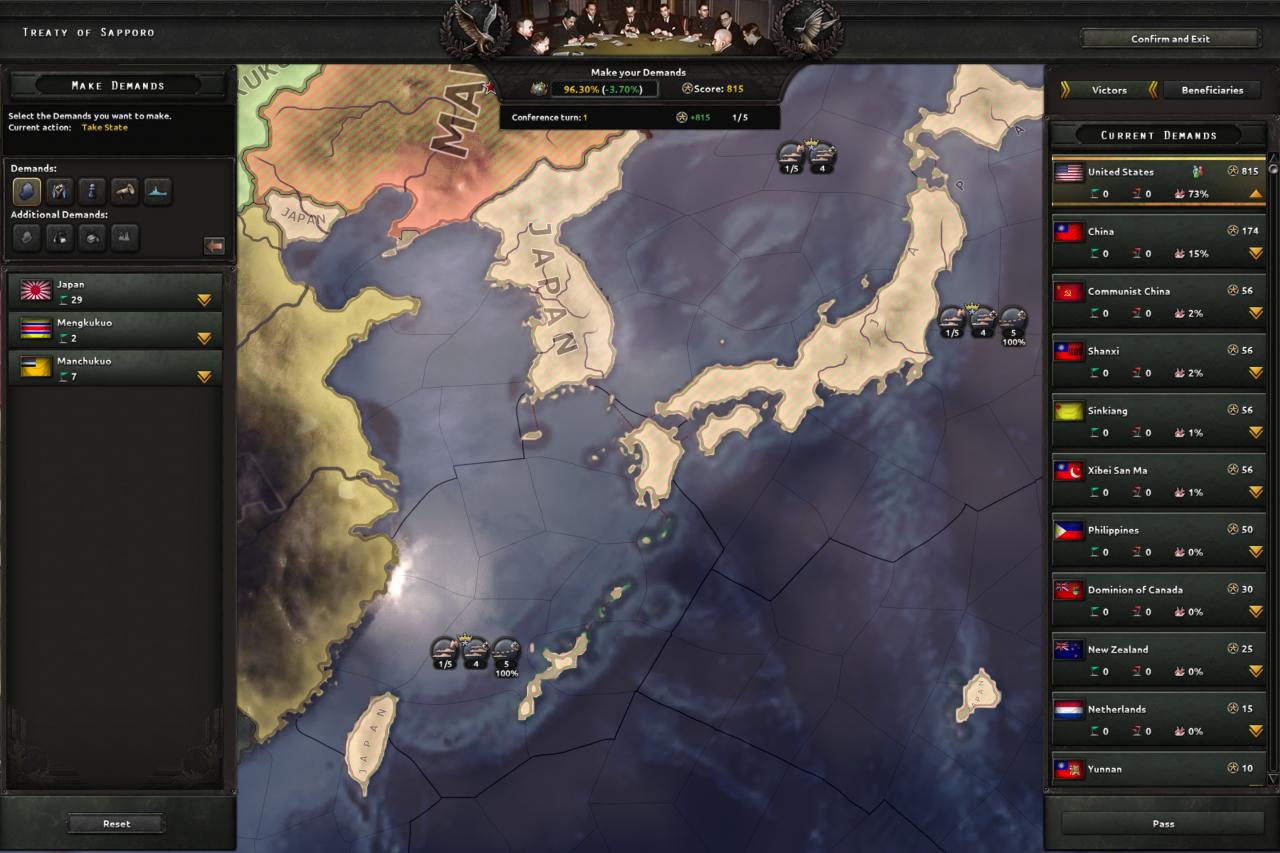
War Score and Turn Information Panel
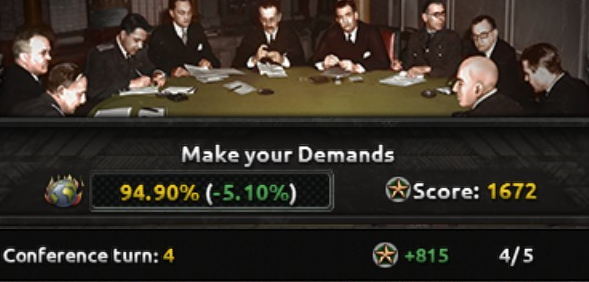 The top part of the peace conference UI (shown at right) displays world tension effects and your currently available war score.
The top part of the peace conference UI (shown at right) displays world tension effects and your currently available war score.
How War Score is Calculated
The war score awarded at the peace conference is calculated based on three values:
- Enemy state value – The combined value of all states controlled by the enemy at the start of the war. Factors contributing to state value are covered in a little more detail later on in this guide.
- Peace score scale factor – This is a constant factor in the HOI4 defines LUA file, and is 1.35 as of patch 1.12.5.
- War participation – The percentage displayed in the War Summary screen during the war. This percentage is calculated by dividing the total of each participant’s war actions points into the total of all participants’ war actions points of the same side. For specifics on how war score points are awarded, see Appendix A.
A particular country’s war score is calculated by multiplying the enemy state value by the peace score scale factor and their war participation percentage. As a simplified example, let’s say Germany, Russia, and Hungary invade Poland, which has a combined state value of about 1100. When Poland capitulates, Germany has 700 war participation points while Russia has 270, and Hungary has 30, for a total of 1000 points. Germany’s war participation is 70% while Russia’s will be 27% and Hungary’s will be 3%. The total war score to be awarded to all participants is 1100 * 1.35 = 1485, and Germany’s war score is 1485 * 0.7 = 1039.5.
How War Score is Distributed
When you are the only victor in the conference, your total war score is issued to you on the first turn. In cases where you are the the only victor, you will generally be able to annex, puppet, liberate, and/or change government of all defeated country states, though you may be left with insufficient war score for additional demand types (e.g., taking naval vessels).
When there are multiple victors in the conference, every victor’s war score will be issued in 20% increments over five turns. Thus, in the above example, Germany will be awarded 1039.5 * 0.2 = 208 war score per turn.
There is an exception to this: a minimum war score per turn formula multiplies the total war score per turn by 5%; any player that would get less than this is awarded an additional portion of their share in order to comprise at least this 5% amount, but only up to their total distribution. Thus, in the above example, the total distribution for all victors per turn would be 1485 * 0.2 = 297, and the minimum war score per turn would be 297 * 0.05 = 14.85. Hungary, whose total distribution is about 45, would get 45 * 0.2 = 9 pts per turn, but since this is lower than 14.85, they would just get 14.85. This would continue for three turns until Hungary got all of its 45 points.
Incremental distribution and minimum war score per turn are balance features designed to allow low war score victors to have some opportunity to make uncontested demands (at least initially).
War Score Indications
Below the current war score is the current conference turn. To the right of this value is the war score that will be issued to you at the start of the next turn, and how many turns remain to issue the remaining war score.
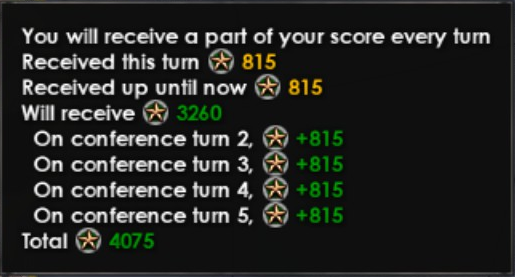 Hovering over these values provides a tool tip (shown at right) summarizing the total war score you are entitled to, including what you currently have available, and what you will receive in future turns.
Hovering over these values provides a tool tip (shown at right) summarizing the total war score you are entitled to, including what you currently have available, and what you will receive in future turns.
Once victors receive all of their war score, they receive no further score on subsequent turns. The finiteness of your war score limits what you can do over the course of the conference and may impose less than perfect options.
Make Demands Panel
The Make Demands panel provides the controls to view and select demands. With the exception of ship demands (see below), all demands are enacted on states of the defeated countries.
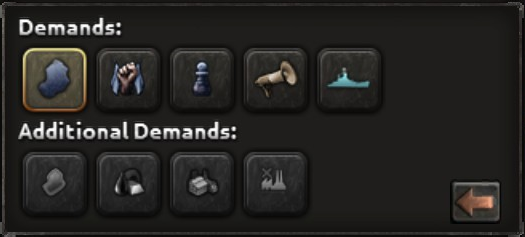 Controls at the top of the panel allow victors to select a demand type. The defeated countries list will then update to show states as that demand type along with their associated costs. Demands selected in the demands list under each defeated country will be of the type selected in these controls until another type is chosen.
Controls at the top of the panel allow victors to select a demand type. The defeated countries list will then update to show states as that demand type along with their associated costs. Demands selected in the demands list under each defeated country will be of the type selected in these controls until another type is chosen.
Demand Types
Players can select from the following demand types:
- Take State – Annexes the selected state to your country.
- Liberate – Liberates the selected state to the country that claims it or has a core on it based on game scripting. If the receiving country does not yet exist, it will be created and will have your country’s ideology.
- Puppet – Creates a puppet with the selected state (or adds it to an existing puppet belonging to you, if applicable). The resulting puppet type will depend on your country’s ideology and may depend on war goals you entered the conflict with.
- Change Government – Preserves the selected state under the existing country, but its government will have the same ideology as yours.
If you have the BBA DLC, additional options include:
- Take Navy – Allows you to take possession of a defeated country’s capital ships (carriers, battleships, heavy cruisers). Individual screening ships (light cruisers, destroyers, submarines) are not listed; instead, a proportional number of screening ships are included with the demand for each capital ship.
- Add Demilitarized Zone – Restricts positioning of military forces in the selected state for five years.
- Add Resources Rights – Makes the state’s resources available to you for five years. Note that the resources depicted for each state on the map reflects the potential resources after upgrades and so may appear higher than what you will actually start receiving upon conclusion of the conference.
- Add Reparation – Provides half of the state’s current civilian factories to your country for five years.
- Add Dismantle Military Industry – Removes the state’s military factories, degrading the defeated country’s military industrial capacity.
The last four options above are available only when puppet or change government demand type buttons are selected, and can only be performed on states that are selected for puppet or change government demands. The costs displayed will update for puppeting and additional demands depending on demand selections, as depicted in the below table.




Demands List
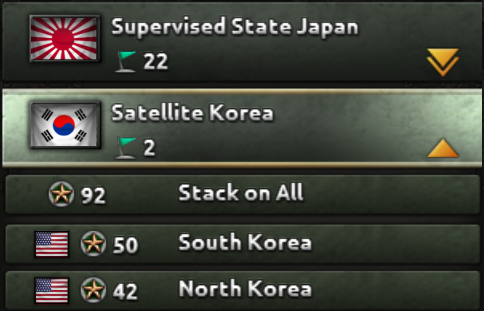 Available demands on each defeated country are shown or hidden by selecting the arrow button to the right of each country. Note that some demand types will include certain countries, while others will not, depending on whether they have states that are eligible for the particular demand type.
Available demands on each defeated country are shown or hidden by selecting the arrow button to the right of each country. Note that some demand types will include certain countries, while others will not, depending on whether they have states that are eligible for the particular demand type.
Green flag and red flag icons provide an at-a-glance number of uncontested and contested demands currently in play for the associated country.
In addition to individual state demands, each demand type provides an ‘…All’ option under each country, which will perform the selected demand type on all states of that country if there is sufficient war score for it.
Selecting a demand will add it as an Un-submitted Demand in the Current Demands panel, described in further detail below, and deduct the associated demand costs from your available war score. Selecting the Reset button will cancel all un-submitted demands, and refund the war score.
Hover Tool Tip
Hovering over each demand displays a tool tip with more details of the demand, including its costs, beneficiary country, puppet type that will be created, other countries contesting, world tension effects, etc. This tool tip also displays in the map when hovering over the associated state, as shown below.
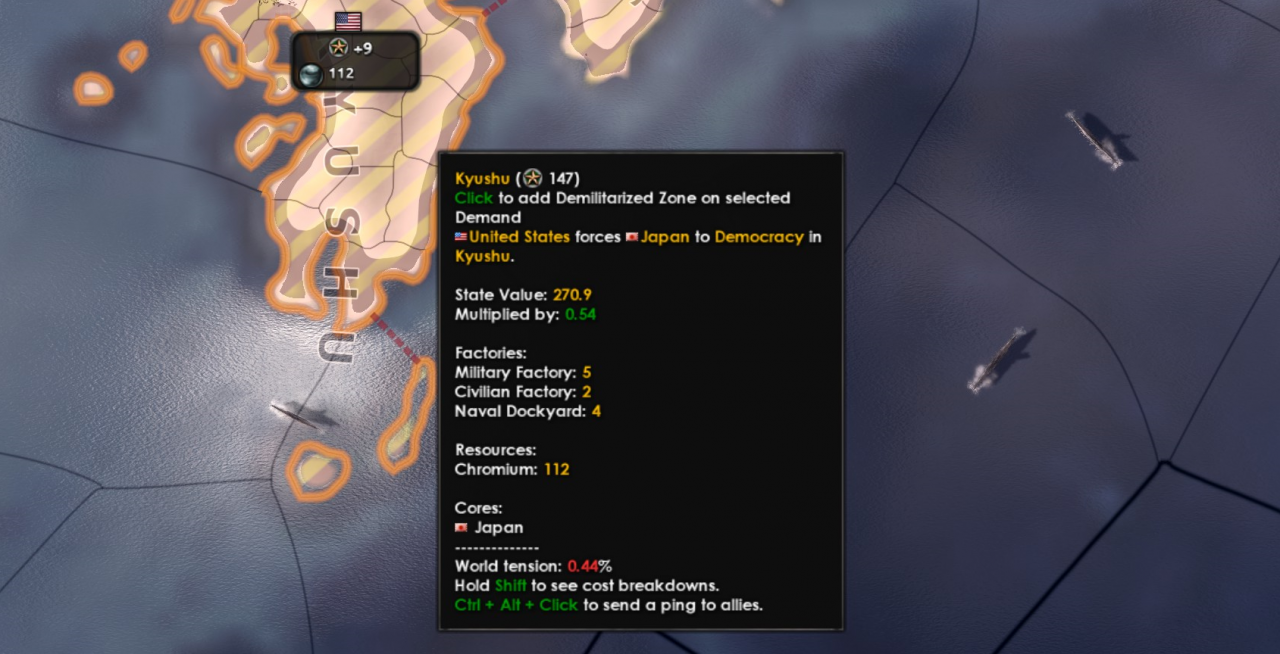
Demand Costs
Demand costs are displayed in the tool tip when hovering over the demand or over the associated state, as described above. A detailed breakdown of what contributes to the cost is available by holding the SHIFT key while hovering, as shown below.
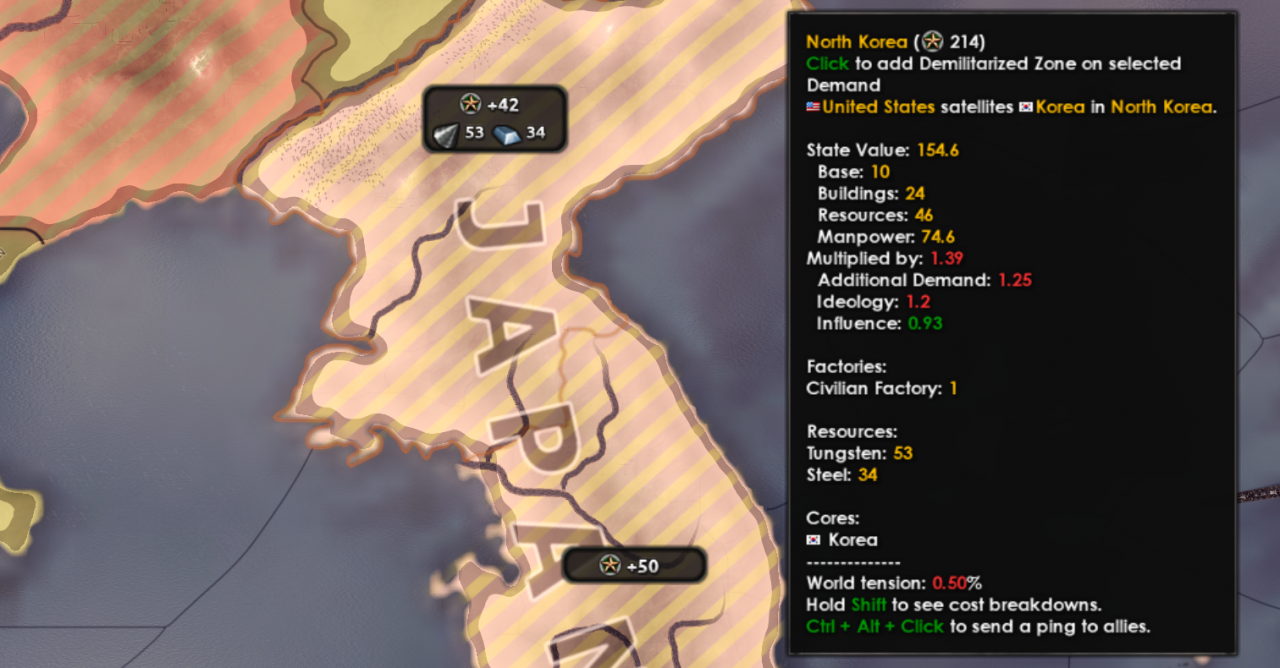
Demand costs for each state are computed from the state’s value multiplied by various modifiers. Costs will vary between victors for a particular demand due to the victor’s characteristics, the defeated state’s characteristics, and demands already made on the state.
State Value
A state’s value is the sum of its base value, buildings in the state (factories, refineries, etc.), resources, and manpower. These costs remain static during the peace conference.
- Base value – Every state has a base value of 10.
- Manpower – Calculated by taking the total state population and dividing by 100,000.
- Resources – Points from resources approximate to 50% of the total resources currently available in the state (e.g., if Scottish Highlands has 32 steel, 2 chromium, and 18 aluminum totaling 52 resources, then the associated cost is 26). Note: I’ve observed some variation on this computation, and have not been able to identify other factors involved.
- Buildings – Sum of point values for the state’s category plus points for each level of each building type. See Appendix B at the end of this guide for a list of values associated with each state category and building.
Modifiers
Modifiers are factors multiplied against the state value to either increase or decrease the total cost. Factors less than 1.0 will decrease the cost, while factors greater than 1.0 will increase the cost. The summary of modifiers displayed in the UI tool tip (i.e., the ‘Multiplied by’ value) is computed by multiplying all active modifiers by each other. This product is then multiplied by the total state value to arrive at the war score cost for the state.
Three dynamic modifiers are specifically functions of the peace conference mechanic:
- Contested – This modifier is added on the next turn to a state that is demanded by two or more countries. Each turn, this modifier increases if it remains contested. Once others stop contesting it, it stops increasing, but the Contested factor will remain at its last value before it became uncontested. As of patch 1.12.5, this modifier increases each turn by multiplying 1.2 by itself. The modifier is capped at 15.
- Uncontested – This modifier is added on the next turn to a state that is demanded by another country with no other country currently making a demand on the state. Each turn, this modifier increases exponentially if it remains uncontested, and can become the biggest factor in demand costs. Once another participant contests it, it stops increasing, but the Uncontested factor will remain at its last value before it became contested. As of patch 1.12.5, this modifier increases each turn by multiplying 1.15 by itself plus 0.15 each turn up to 1.6. The modifier is capped at 15.
- Additional demands – Adding demands such as Add DMZ or Add Resource Rights on top of puppeting a state or changing its government will add to its cost by about 25% for each additional demand. Note that Resource Rights will be 25% of the puppeting costs regardless of how many resources are available in the state.
Costs for contested and uncontested status up to turn 6 are listed in the below table, demonstrating that both increase exponentially, but uncontested increases much more beyond turn 2.
Additional static modifiers include:
- Is Core – Decreases demand cost when the state is your core.
- Is not Capitulated – Increases demand cost (usually occurs when faction leader capitulates, taking their smaller allies into the peace conference as defeated countries without capitulating).
- Ideology – Decreases or increases demand cost depending on demand type and your ideology. For example, fascists get a discount for taking states and are penalized for liberating states, whereas democracies get a discount for liberating states and are penalized for taking states.
- Core of Ally – Increases demand cost when making demands on an ally’s core.
- Compliance – Decreases take state cost depending on level of compliance in the state.
- Can be Liberated – Increases take state or puppet cost.
- Defensive War – If in a defensive war, may decrease liberate state cost.
- Occupation – Decreases demand cost if you occupy the state.
- Events or Focuses – May increase or decrease demand costs on certain states (e.g., Panay incident effects).
- Influence – May decrease or increase costs depending on how close the state is to your territories.
The cost cap for any single demand is 9999 (some demands may get this high, usually a result of high value states going uncontested for many turns). The modifiers are defined in two places (I am not sure why they are redundantly defined or which one takes precedence):
- In cost modifier files located in the following filepath of your HOI4 directory: …\Hearts of Iron IV\common\peace_conference\cost_modifiers\
- In the defines LUA file of your HOI4 directory: …\Hearts of Iron IV\common\defines\
Additional detail on modifiers values is provided in Appendix C at the end of this guide.
Current Demands Panel
Demands selected in the Make Demands panel get added to your country in the Current Demands panel on the right side of the UI, where they are grouped by demand type and affected country. All of these groups can be expanded or hidden with arrow buttons on the right.
Prior to end of turn, un-submitted demands are bracketed with yellow chevrons. An Un-Submitted Demands slot appears in the list of current demands and clicking on it opens a summary of the pending demands. After the turn, if the demands go uncontested, the chevrons are removed and the Un-Submitted Demands slot disappears.
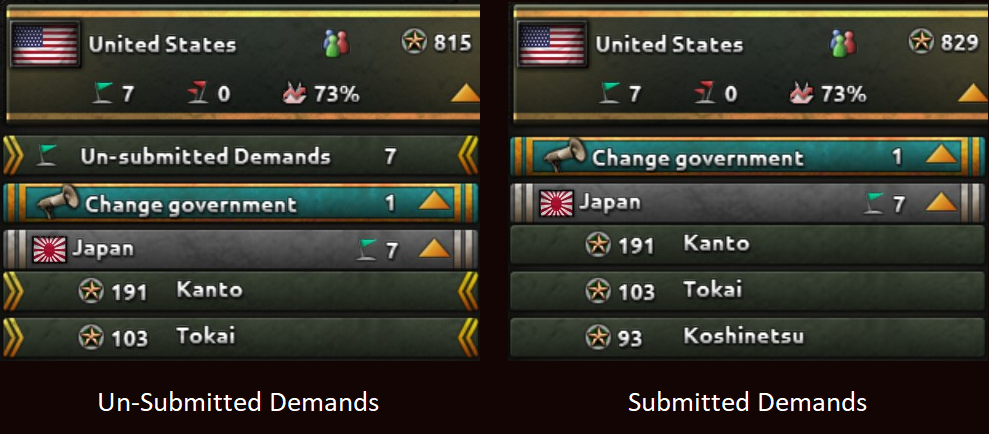
As with the Make Demands list and map, hovering over demands under your country list displays a tool tip with detailed information of the demand. Clicking an un-submitted demand will cancel it and refund any points that were deducted from your war score. You cannot cancel submitted demands.
Demands made by other countries are also displayed under their respective list. Each country’s available war score is displayed to the right.
This panel is also used to select victors as beneficiaries of your demands. By default, your country is selected, so any demands made are given to you; but upon selecting another country, subsequent demands selected will be given to the selected country until it is deselected. The current beneficiary is indicated with horizontal yellow bars, as shown below.

Beneficiaries Panel
Selecting the Beneficiaries button switches from displaying victors to displaying puppets and liberated countries and lists the states that they receive as a result of puppeting and liberating demands, as shown below.
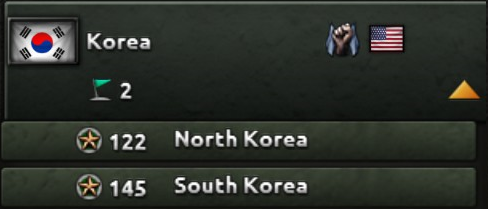 This list is read-only and these countries cannot be directly selected in this panel as beneficiaries. Rather, their beneficiary status for a given state is determined by whether you select the applicable demand type under their country name in the left hand panel. This effectively limits what can be given to a puppet or liberated country to just what is scripted in the game files (e.g., one cannot give Hong Kong to Mexico).
This list is read-only and these countries cannot be directly selected in this panel as beneficiaries. Rather, their beneficiary status for a given state is determined by whether you select the applicable demand type under their country name in the left hand panel. This effectively limits what can be given to a puppet or liberated country to just what is scripted in the game files (e.g., one cannot give Hong Kong to Mexico).
In some cases, you may have multiple options (e.g., you can puppet either existing Japan or a new Korea with South Korea as a state in either case).
Note that this panel is not where you select victors to benefit from your demands. That is done in the Victors panel, as described above.
Submitting and Contesting Demands
Upon selecting Submit Demands, the turn ends and the peace conference system evaluates all demands from conference participants. Demands submitted by only one victor are considered uncontested and are essentially granted to that victor until another victor decides to select that demand in a future turn.
Demands submitted by you and one or more other victors are considered contested and the associated war score points are temporarily refunded to you. The Contested Demands window displays, presenting you with a decision:
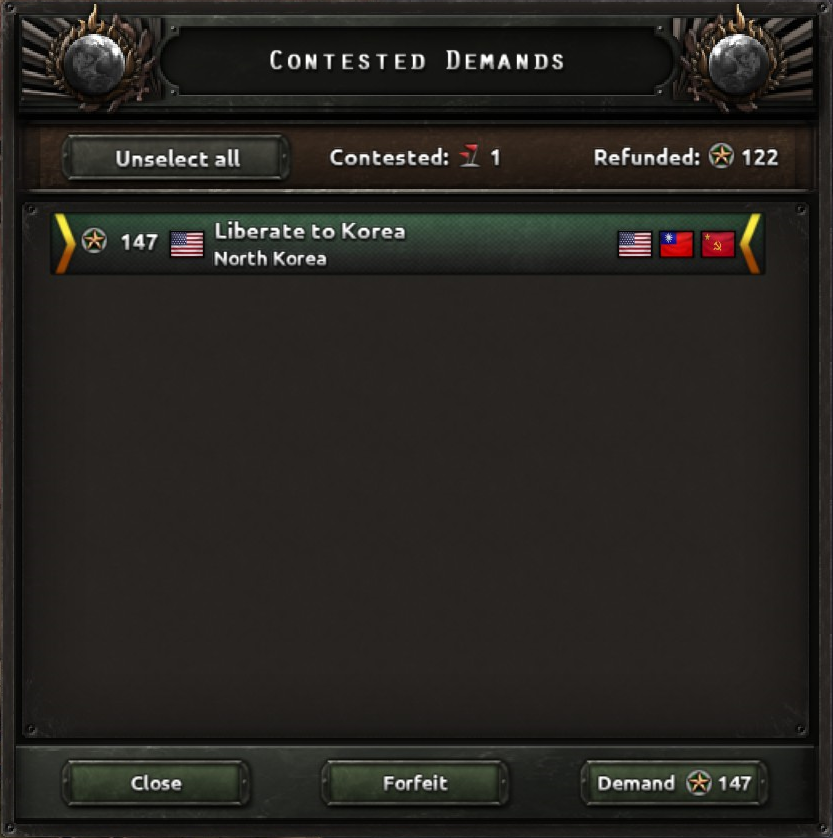 You can continue contesting your demand(s) with an increased cost due to the Contested modifier. Do this by selecting the demand(s) and then selecting Demand. The demand is re-added to your list of Un-submitted demands with the new cost in the Current Demands panel and will then be resubmitted when you select Submit Demands at the end of the next turn.
You can continue contesting your demand(s) with an increased cost due to the Contested modifier. Do this by selecting the demand(s) and then selecting Demand. The demand is re-added to your list of Un-submitted demands with the new cost in the Current Demands panel and will then be resubmitted when you select Submit Demands at the end of the next turn.
You can forfeit your demand(s) and keep the refunded points. If another country continues contesting it, they will do so at the increased cost, thus impacting their available war score. The demand will no longer appear under your country in the Victors panel unless you decide to select the demand again. Note: points you spend to contest a territory are fully refunded on the first turn of contesting, but each subsequent turn, this refund is reduced by 10% down to a low of 70%.
The Contested Demands window allows you to contest or forfeit some, all, or none of the listed demands. Forfeiting does not preclude you from selecting the demand again during the next turn.
Along these lines, it is possible to select a demand for a state that is already demanded by another victor and uncontested as long as you have sufficient war score for it, though there will be increased and potentially significant costs over the original demand cost as discussed above.
If you select more demands than you can afford with your available war score, the Submit Demands button will become unavailable until you remove some of your demands. This also occurs if contesting demands from the Contested Demands window results in exceeding your available war score.
Ending Peace Conferences
The peace conference ends when you select the Confirm and Exit button. Upon exiting the conference, other victors might submit additional demands if they have the war score for it, and this could include contesting your demands.
Note that you can select the Confirm and Execute button at any time without having spent all of your war score, and the game will neither warn nor prevent you from pressing the button in this case. It is important that you verify that you do not have remaining war score that could be spent on any last remaining affordable demands.
Additionally, it is possible for a defeated country to survive with some states if you and other victors failed to demand those states, either due to forgetting about residual war score or prioritizing war score on other demands (i.e., contested demands, ship demands, DMZs, etc.).
Tips and Strategies
The following are some guidelines for how to set yourself up and execute at least somewhat successful peace conferences.
In general, the biggest factor that is outside of your control in PCs are other victors, and if you can prevent other belligerents getting involved, you should. This could mean avoiding calling in allies or waiting for an existing war to end before getting involved. Weigh those decisions against the benefits fighting alongside others.
Pre-War
If you can gain some territory through focuses without war prior to engaging in it, consider prioritizing that. Examples include the Destroyers for Bases focus for USA, and the various Rhineland tree focuses for Germany. And land gained peacefully is land that you don’t have to bid on in a peace conference.
Particularly for small-scale wars, consider staging naval invasions from friendly territory instead of planning invasions through land borders that require calling in another belligerent at the start of a war. Naval invasions can typically be performed from territory controlled by you, a puppet, or a country you have military access with, without having to call them in. Invading through land borders risks giving control of the target country to the ally you’re invading from, which will give them occupation points that you fought for.
During the War
For both small and major wars, most war participation will come from occupation and land combat damage. For small, short wars, air combat, bombing, and ship damage will usually not have time to build. For long, major wars, occupation and land combat will continue to be major contributors, but air combat, bombing, and ship damage will likely have more opportunity play a role.
As with the old system, occupation can be optimized by capturing victory points before other belligerents can. Every 5 VP equates to about 2 war participation points. If you have maneuver units, use them to get a jump on higher VP provinces before others can get there; for a freshly initiated war, this will also have the affect of limiting the war participation others can gain through combat and IC damage.
Do not expect much war score from lend lease. As of the 1.12.5 patch, lend lease IC and fuel are considerably buffed, particularly fuel which requires 100,000 units of oil for one war participation point. Long wars are potentially an opportunity to get a few extra percentage points with IC lend lease, but only if you have substantial surplus.
During the Peace Conference
The demands you select, and the optimal order in which you select them are likely to be situational. The following principles may help.
Your Share of War Participation – More than anything, this will probably dictate what you do. Are you low-scoring (<30%), mid-scoring (30-70%), or high-scoring (>70%)?
AI priorities – In general, the AI will prioritize their cores, claims, and neighboring states, and you can use this to identify where you might be less likely to be uncontested to start, or how you can be obnoxious toward allies.
General strategies – Based on your war participation and your goals, there are a couple of strategies that you can use (and not necessarily in exclusion to one another).
- Low-scoring – It is generally best to prioritize any cores or neighboring states, as these will often be more affordable due to core and/or influence modifiers. You will not likely be able to contest other types of states and you may still have to fend off contests from high scorers on your desired states.
- Mid-scoring – Prioritize near states and distant states that you have discounts in due to focuses, occupation, compliance, etc. Some contesting may be required.
- High-scoring – Demand as much as you can but keep an eye on other victors. Even if you have high score, it is important to remember that uncontested demands from other victors, even if they don’t have much war score, will start automatically increasing in cost due to the modifiers. When you have >80% WS, I recommend contesting any strategically vital claims that others are making to avoid losing out.
Specific Situations – Here are a few additional tools and situations to consider:
- Temporary contest – Submit a demand on a state that you know another victor wants and contesting it for one turn will add the ‘contested’ modifier, permanently increasing the cost for them. Dropping the contest after one turn refunds the points to you at no cost. Against the AI, this could potentially reduce their ability to contest you on other bids later. There’s a potential downside in that the other victor could decide to drop the contest, leaving you with the state that you may or may not want, and also there’s the opportunity cost of spending points on the contest that you could be spending elsewhere.
- Neutral buffers – This is probably more useful for democracies. You can accomplish this either by liberating states or changing their government. This prevents the potential adversary from getting control of the state, while also keeping your hands clean of it. When liberating, pay attention to whether the state will get added to an existing country and whether that country might want to align with the adversary.
- Staging – Claim territories that will put you in a good position to attack other countries including another victor. For example, as USA, you defeat the Allies together with Germany. You may not have high WS, but you probably have enough to take the west coast of France, which could give you a staging area to attack Germany without the heartache of a naval invasion, and then you can take all of Germany’s territories.
- Democratic puppeting – When you are democratic, many defeated countries present you with options to puppet all or most of their states, or make a few smaller puppets from their states. In the former case, the defeated countries are scripted to become supervised states, while the latter are scripted to become satellites. Supervised states can’t be reduced in autonomy to the point of annexation and will eventually gain enough autonomy to become independent. Unless you’re okay with this, you should just annex them in the peace conference and them release them as a normal puppet from the Occupied Territories window later.
- Ships and Additional Demands – Unless you do not need or want any states, I recommend using the Take Navy and additional demands last. Even when you are the only victor with points, in many cases, the total war score awarded is not sufficient for all ships or additional demands depending on the demand type you use on ships.
Prior to pressing the Confirm and Exit button, it is highly recommended to:
- Look at the ‘next turn’ war score value to the right of the Conference Turn number at the top to ensure there is no additional war score that might be awarded on a future turn.
- Review demands of each type in the Make Demands panel to ensure there are no additional cheap options (e.g., liberating a state with your ideology as a democratic victor) that you can afford with residual war score.
Appendix A: War Participation Factors
Note: The below guidance is based in part on the defines LUA file in the HOI4 folder as of patch 1.12.5, but also on in-game observations. I have not been able to validate all of this precisely, so consider it a rough guide. As a reminder, the below values are war participation points, not war score points. See the War Score section above to learn how war participation points are used to calculate war score.
- Occupation – Points awarded per province captured. Based on in-game observations, appears to calculate as: s/(2p)+(2v/5), where s = value of the state containing the province, p = number of provinces in the state, and v = victory points of the province. While there is a multiplier in the defines file that is supposed to double the points on first capture of a province, in-game observations showed that points are awarded only for first captures, with no points awarded for recapturing after losing a captured province.
- Casualties – Every 1000 casualties you suffer awards 0.5 points (e.g., Germany suffers 1,000,000 casualties fighting Russia for 2 years, gaining 1000000 / 1000 * 0.5 = 500 points).
- Land Combat Damage – Every point of enemy strength awards 0.1 points. This appears to be referring to enemy division hit points, but have not been able to validate with confidence (e.g., you destroy a unit that had 50 HP, gaining 5 points). There is an additional 20% gain if you are the attacker and winner. Based on in-game observations, this appears to be capped at 5 points per division, regardless of how many battalions/HP the division has.
- Land Combat IC Damage – Every point of enemy IC damage for equipment awards 0.1 points (e.g., destroying a division that has 1000 infantry equipment worth 0.5 IC each would award 1000 * 0.5 * 0.1 = 50 points). This is part of Land Combat Damage in the War Summary window and appears to be the biggest part of it.
- Strategic Bombing – Every damage point against enemy buildings awards 0.02 points. This decays every month by 0.1 per enemy civilian factory in service.
- Air Combat IC Damage – Every point of IC damage for enemy aircraft shot down awards 0.1 points (e.g., a basic 1936 fighter costing about 25 IC gets shot down, gaining 2.5 points).
- Lend Lease IC – Each point of IC sent to Allies awards 0.001 points. Conversely, each point of IC you receive deducts 0.001 points.
- Lend Lease Fuel – Every 100 units of fuel awards 0.001 points. Conversely, every 100 units of fuel you receive deducts 0.001 points.
- Sunk Manpower – Every enemy sailor (i.e., manpower) killed when you sink a ship awards 0.001 points.
- Sunk Ships IC – Every point of IC damage for ships sunk awards 0.004 points.
- Sunk Convoys IC – Every point of IC damage for convoys sunk awards 0.05 points. This decays by 0.03 points per enemy convoy newly built.
Appendix B: Building Costs
State Category
Buildings
Appendix C: Cost Modifiers
Static Modifiers
*Non-core states only.
Variable Modifiers
When taking state, modifier is:
- 1.0 for <30% compliance
- 0.9 for 30 – 70% compliance
- 0.8 for > 70% compliance
Thanks to apudzuf for his excellent guide, all credit to his effort. if this guide helps you, please support and rate it via Steam Community. enjoy the game.
Related Posts:
- Hearts of Iron IV: How to Fix Mod Not Showing Up Issue
- Hearts of Iron IV: By Blood Alone DLC Guide
- Hearts of Iron IV: Romania MP Guide
- Hearts of Iron IV: How To Make Custom Radio Stations
- Hearts of Iron IV: How to Fix Missing Modifications 2021

